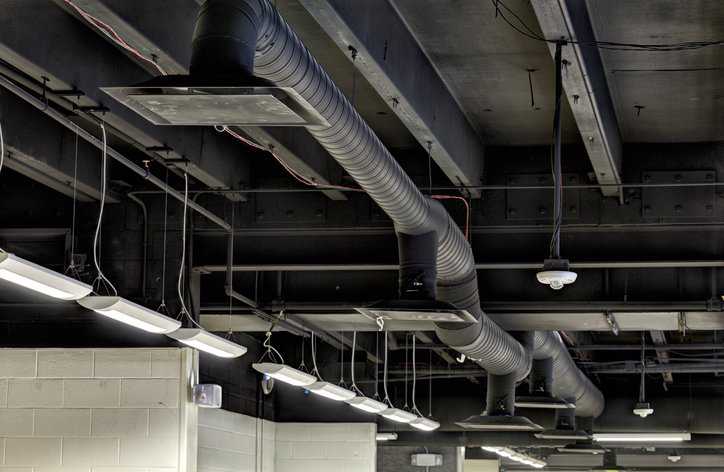SMACNA Fire, Smoke & Radiation Damper Installation for HVAC

Fire and smoke dampers are installed in ductwork, ceiling cavities, and other barriers. If a fire breaks out, they are designed to close and suppress the spread of smoke and fire throughout the building. They are a key component of fire protection systems and are life safety devices helping protect the occupants of a building in the event of a fire. Fire, Smoke, and Radiation Damper Installation Guide for HVAC Systems, 6th Edition specifies best practices for installing fire, smoke, and radiation dampers.
Importance of Dampers in an HVAC System
Dampers are crucial components in an HVAC system because they regulate the airflow to different areas of a building, allowing for precise temperature control in individual rooms or zones. This prevents overcooling or overheating, ultimately contributing to energy efficiency by directing air to only where it is needed. By restricting airflow, using an HVAC damper helps to conserve energy.
Dampers for Fire Installation
Fire dampers are designed to (and required to) close automatically upon detection of heat (such as a fusible link or heat detector) and to interrupt airflow and to restrict the passage of flame. Damper installation seals off openings in fire-rated walls, floors, and ceilings—typically located at duct penetrations where fire compartmentalization is required. Under severe fire exposure, a duct may eventually collapse or significantly deform, creating an opening in the fire barrier. Fire dampers provide a method of protecting such penetrations and openings.
Fire dampers are often installed in combination, with smoke dampers to control smoke spread and radiation dampers to limit heat transfer in specific situations. Ultimately, the installation of fire dampers within an HVAC system, designed to automatically close in case of a fire, is essential in preventing the spread of flames, smoke, and radiant heat through the ductwork.
What Is the Fire, Smoke, and Radiation Damper Installation Guide for HVAC Systems, 6th Edition?
The SMACNA – Fire, Smoke, and Radiation Damper Guide outlines requirements and practices in specifying and installing fire dampers, smoke dampers, combination fire and smoke dampers, and ceiling (radiation) dampers. This Guide also clarifies the responsibilities of designers, contractors, and code officials as mandated by the model building codes. The SMACNA – Fire, Smoke, and Radiation Damper Guide illustrates generic methods for installing fire dampers, smoke dampers and ceiling dampers associated with HVAC systems.
Essentially, this manual, which was published by the Sheet Metal and Air Conditioning Contractors’ National Association (SMACNA), aims to provide clarity on the responsibilities designers, engineers, contractors, manufacturers, testing agencies and local authorities having jurisdiction have or share regarding fire and smoke dampers systems.
What Are the Types of Life Safety Dampers?
Life safety dampers are barriers that close to contain smoke and fire in the event of a fire, helping to protect people and property. They are a vital part of a building’s ventilation system and are installed in the HVAC system. They are used to protect openings over a wide variety of construction designs typically encountered in a building project.
Fire, Smoke, and Radiation Damper Installation Guide for HVAC Systems details that there are five basic types of life safety dampers:
- Fire Damper: Prevents the spread of fire past the damper assembly at the openings or penetrations of vertical or horizontal fire resistance rated assemblies
- Smoke Damper: Limits the spread of smoke past the damper at openings of vertical or horizontal fire resistance rated assemblies, smoke barriers, or smoke partitions
- Combination Fire and Smoke Damper (e.g., Modulating Fire/Smoke Damper): Provides both functions of a fire and smoke damper
- Ceiling Radiation Damper. Limits the passage of fire and heat through or around the damper at penetrations of fire-rated ceiling assemblies
- Corridor Damper. Prevents the spread of fire and smoke past the damper in a corridor ceiling where the corridor is constructed as a fire-resistance rated passage
Fire, Smoke, and Radiation Damper Installation Guide for HVAC Systems, 6th Edition is available on the ANSI Webstore.







Preventive air conditioning service and repair is often overlooked until the system fails. Regular tune-ups, filter replacements, and performance checks help businesses and homeowners avoid discomfort and high emergency repair costs